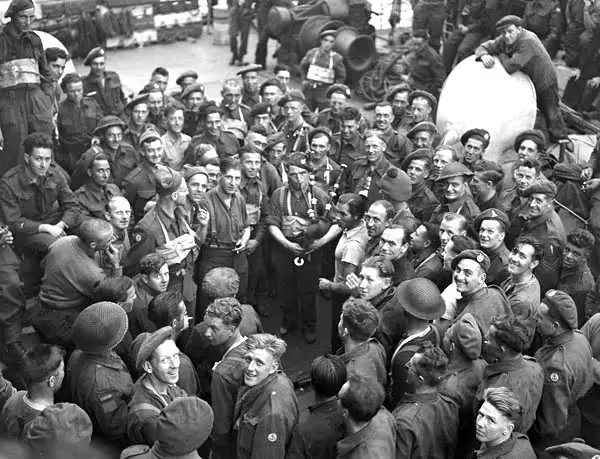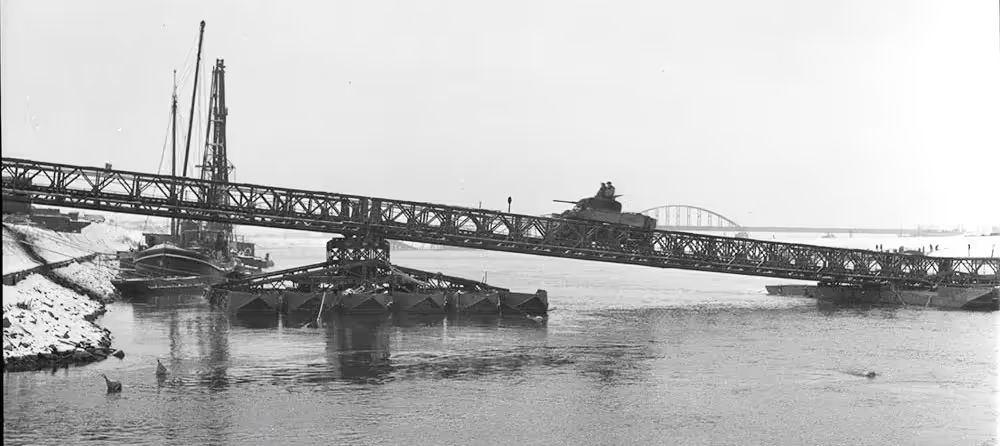Royal Canadian Engineers (RCE), North West Europe 1944-1945
Royal Canadian Engineers in North West Europe, 1944-1945
.avif)
(Author Photo)
(New Brunswick Military History Museum Collection)
First Canadian Army, Royal Canadian Engineers (RCE)
The Corps of Royal Canadian Engineers expanded dramatically in size to support Canada's war effort. On 31 August 1939, the Permanent Force engineers included 50 officers (with 14 seconded to other branches of the Canadian Army) and 323 other ranks; the maximum size of the Corps was reached in 1944, when it included 210 officers and 6283 other ranks.
First Canadian Army Headquarters Engineer Platoon
1st Canadian Cemetery Construction Unit
2nd Canadian Cemetery Construction Unit
1st Canadian Special Construction Platoon
2nd Canadian Special Construction Platoon
Royal Canadian Engineers Band
Headquarters RCE, First Canadian Army Troops
5th Field Company
20th Field Company
23rd Field Company
10th Field Park Company
3rd Canadian Electrical and Mechanical Platoon Type A
Headquarters, Second Canadian Army Troops
32nd Field Company
33rd Field Company
34th Field Company
2nd Canadian Army Troops Engineers
11th Field Park Company
No. 1 Workshop and Park Company
1st Field (Air) Survey Company
2nd Field Survey Company
3rd Field (Reproduction) Company

(Library and Archives Canada Photo, MIKAN No. 3227577)
Lieutenant Leslie Herbert Browne, Royal Canadian Engineers, playing his David Glen bagpipes aboard a ship en route to France on D-Day, 6 June 1944.

(Library and Archives Canada Photo, MIKAN No. 3396149)
Personnel of No. 1 Workshop and Park Company, Royal Canadian Engineers (RCE), examining damaged rail cars, Vaucelles, France, 23 July 1944.

(Library and Archives Canada Photo, MIKAN No. 3225555)
Sapper J.B. Sweeney and Lance-Corporal C.K. Halmsley of the Royal Canadian Engineers (RCE) pounding in safety stakes along a road in Vaucelles, France, 23 July 1944.

(Library and Archives Canada Photo, MIKAN No. 3231689)
Infantrymen resting in a damaged streetcar, Vaucelles, France, 18 July 1944.
Headquarters, First Canadian Mechanical and Equipment Company
1st Canadian Mechanical Equipment Park Company
1st Canadian Mechanical Equipment Platoon Type B
2nd Canadian Mechanical Equipment Platoon Type B
3rd Canadian Mechanical Equipment Platoon Type B
4th Canadian Mechanical Equipment Platoon Type B
1st Canadian Machinery Spare Parts (Base) Section
DCE (Works) First Canadian Army
1st Canadian CRE Works
1st Canadian Work Section
2nd Canadian Work Section
3rd Canadian Work Section
1st Canadian Engineer Stores Platoon
2nd Canadian Drilling Company
5th Canadian Drilling Platoon
6th Canadian Drilling Platoon
7th Canadian Drilling Platoon
8th Canadian Drilling Platoon
1st Canadian Road Construction Company
2nd Canadian Road Construction Company
1st Canadian Workshop and Park Company
4th Canadian Electrical and Mechanical Platoon Type A
DD (Survey) First Canadian Army
1st Canadian Field Survey Depot
2nd Canadian Field Survey Depot (Topo)
3rd Canadian Field (Reproduction) Survey Company
1st Canadian (Air) Survey Company
1st Canadian Modelling Team
DCE (Permanent Bridges) First Canadian Army
Canadian CRE Permanent Bridges
2nd Battalion, RCE
3rd Battalion, RCE
1st Canadian Pile Driving Platoon
2nd Canadian Pile Driving Platoon
Headquarters, No. 2 Canadian Railway Operating Group, RCE

(Library and Archives Canada Photo, MIKAN No. 3396270)
Sapper W.H. Lindstrom, 2nd Field Company, Royal Canadian Engineers (RCE), sweeping for mines at a roadblock, Kappellen, Belgium, 5 October 1944.

(Library and Archives Canada Photo, MIKAN No. 3378347)
Gunners of "X" Battery, Royal Canadian Artillery (RCA), digging a breech pit for a captured 155-mm gun to be used to fire on Dunkirk. Adinkerke, Belgium, 15 September 1944.

(Library and Archives Canada Photo, MIKAN No. 3524627)
Looks like an M3 Stuart light tank crossing the double landing bay of the 'Quebec' bailey bridge installed by the Royal Canadian Engineers (RCE) over the River Maas. Ravenstein, Netherlands, 1 February 1945.

(Library and Archives Canada Photo, MIKAN No. 3225213)
An RCE armoured bulldozer behind a pair of scissors bridges mounted on Churchill tank chassis, in line waiting to move up during an attack on the Western Front, 8 Feb 1945.

(Library and Archives Canada Photo, MIKAN No. 3225214)
Scissors bridge line up waiting to move up during the attack on the Western Front, 8 Feb 1945.

(Library and Archives Canada Photo, MIKAN No. 3405825)
Signalman J. Bennett of the 1st Canadian Railway Telegraph Company, Royal Canadian Engineers (RCE), installing wire on a pole in the railway yards, Louvain, Belgium, 6 January 1945.
1st Canadian Railway Operating Company
2nd Canadian Railway Operating Company

(Library and Archives Canada Photo, MIKAN No. 3223319)
A Royal Canadian Engineers (RCE) sapper examining "Jackbits" detachable drills, England, ca. 1944.

(Library and Archives Canada Photo, MIKAN No. 3356107)
Personnel of No. 1 Railway Workshop Company, Royal Canadian Engineers (RCE), preparing to repair damaged locomotives, Vaucelles, France, 23 July 1944.
1st Canadian Railway Workshop Company

(Library and Archives Canada Photo, MIKAN No. 3392827)
Personnel repairing a bomb-damaged truck of the 1st Canadian Railway Telegraph Company, Royal Canadian Engineers (RCE), Louvain, Belgium, 6 January 1945.
1st Canadian Railway Telegraph Company, RCCS

(Library and Archives Canada Photo, MIKAN No. 3227245)
RCE bulldozer clearing rubble from the streets near the ruins of a church in Normandy, 16-17 August 1944.

(Library and Archives Canada Photo, MIKAN No. 3226711)
Bull-dozer in action widening the cross-roads immediately after it was cleared by sappers of the Royal Canadian Engineers, 9 July 1944.

(Library and Archives Canada Photo, MIKAN No. 3226712)
Bull-dozer in action widening the cross-roads immediately after it was cleared by sappers of the Royal Canadian Engineers, 9 July 1944.

(Library and Archives Canada Photo, MIKAN No. 3226399)
Sappers of the 16th Field Company, Royal Canadian Engineers (RCE), removing a damaged rail from the Paris-Cherbourg railway line near Carpiquet, France, 8 July 1944.

(Library and Archives Canada Photo, MIKAN No. 3529259)
Lieutenant M.O. Rollefson and Sapper H.T. Work, 9th Field Squadron, Royal Canadian Engineers (RCE), examining a section of railway track blown by their demolition charge near the Hochwald, Germany, 2 March 1945.

(Library and Archives Canada Photo, MIKAN No. 3220016)
Lieutenant-Colonel Charles Petch, Commanding Officer, leading The North Nova Scotia Highlanders across London Bridge, an RCE Bailey bridge built across the Odon River south of Caen, France, 18 July 1944.

(Library and Archives Canada Photo, MIKAN No. 3524628)
View of the sliding bay of the 'Yardley' bailey bridge installed by the Royal Canadian Engineers (RCE) over River Maas. Ravenstein, Netherlands, 1 Feb. 1945.

(Library and Archives Canada Photo, MIKAN No. 3524629)
View of fixed approach spans on west bank of 'Quebec' bailey bridge mounted on crib piers as installed by the Royal Canadian Engineers (RCE) over River Maas, Ravenstein, Netherlands, 1 February. 1945.
.avif)
(Library and Archives Canada Photo, MIKAN No. 3202191)
Corporal Urban Mayo of the 13th Field Company, Royal Canadian Engineers (RCE), reading a sign which states, "You are entering Germany - Be on your guard", Wyler, Germany, 9 February 1945.

(Library and Archives Canada Photo, MIKAN No. 3223938)
Opening of Walsh Bridge by Gen. H.D.G. Crerar. Overview of bridge and Royal Canadian Engineers before opening, 26 February 1945.

(Library and Archives Canada Photo, MIKAN No. 3529255)
Personnel of the 9th Field Squadron, Royal Canadian Engineers (RCE), lifting rails to make a road for Canadian vehicles near the Hochwald, Germany, 2 March 1945.

(Library and Archives Canada Photo, MIKAN No. 3224063)
Personnel of the Royal Canadian Engineers building a pontoon bridge across the Dortmund-Ems Canal, 8 April 1945.

(Library and Archives Canada Photo, MIKAN No. 3524159)
Sappers of the 7th Field Company, Royal Canadian Engineers (RCE), sweeping for mines, Doetinchem, Netherlands, 1 April 1945.

(Library and Archives Canada Photo, MIKAN No. 3224535)
Personnel of the Royal Canadian Engineers building a pontoon bridge across the Dortmund-Ems Canal, 8 April 1945.

(Library and Archives Canada Photo, MIKAN No. 3224054)
Personnel of the Royal Canadian Engineers building a pontoon bridge across the Dortmund-Ems Canal, 8 April 1945.

(Library and Archives Canada Photo, MIKAN No. 3192330)
Royal Canadian Engineers using bulldozers to clear bomb damaged streets of rubble in order to start an other road to the river bridges in Normandy, 4 August 1944.

(Library and Archives Canada Photo, MIKAN No. 3250971)
Sergeant Pat Wood and Lieutenant L.F. Labow of the 2nd Drilling Company, Royal Canadian Engineers (R.C.E.), preparing the demolition of former German E-Boat pens, Ostend, Belgium, 21 May 1945.

(Library and Archives Canada Photo, MIKAN No. 3521430)
Sapper J.D. Martel, 3rd Battalion, Royal Canadian Engineers (RCE), tightening couplers during construction of the Ostend-Ghent oil pipeline, Ostend, Belgium, 18 October 1944.

(Library and Archives Canada Photo, MIKAN No.
Personnel of the 3rd Battalion, Royal Canadian Engineers (RCE) lowering a section of the Ostend-Ghent oil pipeline into a trench, Ostend, Belgium, 18 October 1944.

Royal Canadian Engineers badge, King's crown.

(Library and Archives Canada Photo, MIKAN No. 3565318)
One of the smaller Canadian bridges built over the Orne River at Caen in 1944, still greatly in use, particularily by cyclists from the Caen University in 1949.

